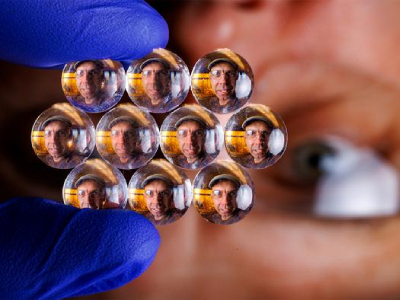
The visage of Stephen Morin, associate professor of chemistry, refracts through an array of lenses. Credit: Craig Chandler, University of Nebraska–Lincoln
Researchers from the University of Nebraska-Lincoln have developed dynamic microscopic lens arrays utilizing hydrogels. The new lenses promise to provide the dynamism missing from current static lens arrays.
The researchers developed gelatinous lenses that can be affixed to an elastic material containing the equivalent of aqueducts to use various fluids to expand or contract the lenses in seconds. In the study, published in Advanced Functional Materials, the researchers presented their findings in which they believe they have created a dynamic lens structure with numerous potential applications.
“The artificial micro-lenses we have today are relatively static,” said Stephen Morin, associate professor of chemistry at the University of Nebraska–Lincoln. “They have a fixed focal length, a fixed size. They are made from materials that give you the lensing property you want, but they don’t really have any dynamic characteristics.”
To address the lack of dynamism in today's lenses the team turned to hydrogels, a class of water-infused polymers commonly used in contact lenses. Previously, the researchers had adhered hydrogel islands to silicone materials, but agitation or lack of sufficient water would inevitably detach the islands from their base. “The problem is that putting those together in a way that they function synergistically is not well-established,” said Morin. “There wasn’t really anything out there that was putting these two materials together in a robust, long-term platform.”
To overcome these challenges the researchers began priming the silicone with a patterned plasma treatment containing strategic molecular groups and a lithium-based compound. After coating the team deposited the islands and applied ultraviolet light that would trigger the propagation of chains that helped to stabilize it. “When it’s all said and done,” Morin said, “you have a somewhat monolithic structure.
Once created, the team tested the stability of the structure by twisting it, stretching it, and even using pieces of tape to attempt to peel off the lenses. “When we were done, we were pretty satisfied that they were stuck on there pretty well,” said Morin. Further testing revealed that by changing the temperature of the water running through the lenses, the team could control the focus due to changes in the refractive index of the lens based on the expansion and contraction of the material.
“I always make the argument that it would be great if, 100 years from now, the materials we made were able to adapt as we grow and change, as opposed to just being designed to stay the same the whole way through,” said Morin. “Of course, this work is just a microcosm of that. But that’s the idea. That’s what adaptive materials could give us.”